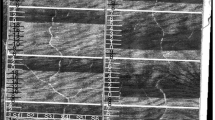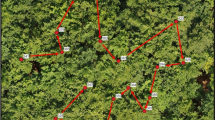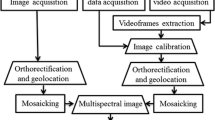Abstract
This paper deals with the assessment of heterogeneity in water status in a commercial orchard, as a prerequisite for precision irrigation management. Remote sensing-derived indicators could be suitable for mapping water stress over large areas, and recent studies have demonstrated that high resolution airborne thermal imagery enables the assessment of discontinuous canopies as pure tree crowns can be targeted, thus eliminating the background effects. Airborne campaigns were conducted over a drip-irrigated commercial orchard in Southwestern Spain composed of five different orchard tree crops. An unmanned aerial vehicle with a thermal camera onboard was flown three times during the day on 8 July 2010, at 9, 11 and 13 h (local time). Stem water potential was measured at the same time of the flights. In some irrigation units, irrigation was stopped prior to the measurement date to induce water deficits for comparative purposes. Several approaches for using the thermal data were proposed. Daily evolution of the differential between canopy and air temperature (T c − T a ) was compared to tree water status. The slope of the evolution of T c − T a with time was well correlated with water status and is proposed as a novel indicator linked with the stomatal behavior. The Crop Water Stress Index (CWSI) was calculated with the temperature data from the 13.00 h flight using an empirical approach for defining the upper and lower limits of T c − T a . The assessment of variability in water status was also performed using differences in relative canopy temperatures. Ample variability was detected among and within irrigation units, demonstrating that the approach proposed was viable for precision irrigation management. The assessment led to the identification of water-stressed areas, and to the definition of threshold CWSI values and associated risks. Such thresholds may be used by growers for irrigation management based on crop developmental stages and economic considerations.







Similar content being viewed by others
References
Alchanatis, V., Cohen, Y., Cohen, S., Moller, M., Sprinstin, M., Meron, M., et al. (2010). Evaluation of different approaches for estimating and mapping crop water status in cotton with thermal imaging. Precision Agriculture, 11, 27–41.
Ballester, C., Castel, J., Intrigliolo, D. S., & Castel, J. R. (2012a). Response of Navel Lane Late citrus trees to regulated deficit irrigation: Yield components and fruit composition. Irrigation Science, 31(3), 333–341.
Ballester, C., Jimenez-Bello, M. A., Castel, J. R., & Intrigliolo, D. S. (2012b). Usefulness of thermography for plant water stress detection in citrus and persimmon trees. Agricultural and Forest Meteorology, 168, 120–129.
Barbagallo, S., Consoli, S., & Russo, A. (2009). A one-layer satellite surface energy balance for estimating evapotranspiration rates and crop water stress indexes. Sensors, 9(1), 1–21.
Berni, J. A. J., Zarco-Tejada, P. J., Sepulcre-Canto, G., Fereres, E., & Villalobos, F. (2009a). Mapping canopy conductance and CWSI in olive orchards using high resolution thermal remote sensing imagery. Remote Sensing of Environment, 113, 2380–2388.
Berni, J. A. J., Zarco-Tejada, P. J., Suarez, L., & Fereres, E. (2009b). Thermal and narrowband multispectral remote sensing for vegetation monitoring from an unmanned aerial vehicle. IEEE Transactions on Geoscience and Remote Sensing, 47(3), 722–738.
Cohen, Y., Alchanatis, V., Meron, M., Saranga, Y., & Tsipris, J. (2005). Estimation of leaf water potential by thermal imagery and spatial analysis. Journal of Experimental Botany, 56(417), 1843–1852.
Cohen, S., & Cohen, Y. (1983). Field studies of leaf conductance response to environmental variables in Citrus (orange). Journal of Applied Ecology, 20, 561–570.
Fereres, E. (1984). Variability in adaptive mechanisms to water deficits in annual and perennial crop plants. Bulletin Societé Botanique de France. Actualités Botaniques, 131, 17–32.
Fereres, E., Orgaz, F., & Gonzalez-Dugo, V. (2011). Reflections on food security under water scarcity. Journal of Experimental Botany, 62(12), 4079–4086.
Fereres, E., & Soriano, M. A. (2007). Deficit irrigation for reducing agricultural water use. Journal of Experimental Botany, 58(2), 147–159.
Fernandez, J. E., & Cuevas, M. V. (2010). Irrigation scheduling from stem diameter variations: A review. Agricultural and Forest Meteorology, 150(2), 135–151.
Girona, J., Marsal, J., & Lopez, G. (2006). Establishment of stem water potential thresholds for the response of ‘O’Henry’ peach fruit growth to water stress during stage III of fruit development. Acta Horticulturae, 713, 197–201.
Goldhamer, D. A., & Fereres, E. (2004). Irrigation scheduling of almond trees with trunk diameter sensors. Irrigation Science, 23, 11–19.
Goldhamer, D. A., & Intrigliolo, D. S. (2012). Citrus. In J. R. Castel, E. Fereres, P. Steduto, T. C. Hsiao, E. Fereres, & D. Raes (Eds.), Crop yield response to water (pp. 316–332). Rome: FAO Irrigation and Drainage Paper 66.
Gonzalez-Dugo, M. P., Moran, M. S., Mateos, L., & Bryant, R. (2006). Canopy temperature variability as an indicator of crop water stress severity. Irrigation Science, 24, 233–240.
Gonzalez-Dugo, V., Zarco-Tejada, P. J., Berni, J. A. J., Suarez, L., Goldhamer, D. A., & Fereres, E. (2012). Almond tree canopy temperature reveals intra-crown variability that is water-stress dependent. Agricultural and Forest Meteorology, 154–155, 156–165.
Idso, S. B., Jackson, R. D., Pinter, P. J. J., Reginato, R. J., & Hatfield, J. L. (1981). Normalizing the stress degree-day parameter for environmental variability. Agricultural Meteorology, 24, 45–55.
Idso, S. B., Jackson, R. D., & Reginato, R. J. (1978). Extending the “degree day” concept of plant phenological development to include water stress effects. Ecology, 59, 431–433.
Irmak, S., Haman, D. Z., & Bastug, R. (2000). Determination of crop water stress index for irrigation timing and yield estimation of corn. Agronomy Journal, 92(6), 1221–1227.
Jackson, R., Idso, S., Reginato, R., & Pinter, P. J. (1981). Canopy temperature as a crop water stress indicator. Water Resources Research, 17, 1133–1138.
Jones, H. G. (1999a). Use of infrared thermometry for estimation of stomatal conductance as a possible aid to irrigation scheduling. Agricultural and Forest Meteorology, 95(3), 139–149.
Jones, H. G. (1999b). Use of thermography for quantitative studies of spatial and temporal variation of stomatal conductance over leaf surfaces. Plant, Cell and Environment, 22(9), 1043–1055.
Jury, W. A., & Vaux, H. R. (2007). The emerging global water crisis: Managing scarcity and conflict between water users. Advances in Agronomy, 95, 1–76.
Molden, D. (2007). Water for food, water for life: a comprehensive assessment of water management in agriculture. London: International Water Management Institute.
Moran, M. S., Clarke, T. R., Inoue, Y., & Vidal, A. (1994). Estimating crop water deficit using the relation between surface-air temperature and spectral vegetation index. Remote Sensing of Environment, 49(3), 246–263.
Moriana, A., Villalobos, F. J., & Fereres, E. (2002). Stomatal and photosynthetic responses of olive (Olea europaea L.) leaves to water deficits. Plant Cell and Environment, 25(3), 395–405.
Naor, A. (2006). Irrigation scheduling and evaluation of tree water status in deciduous orchards. Horticultural Reviews, 32, 111–165.
Perez-Sarmiento, F., Alcobendas, R., Mounzer, O., Alarcon, J., & Nicolas, E. (2010). Effects of regulated deficit irrigation on physiology and fruit quality in apricot trees. Spanish Journal of Agricultural Research, 8(S2), S86–S94.
Rud, R., Cohen, Y., Alchanatis, V., Cohen, A., Sprintsin, M., Levi, A., Brikman, R., Heuer, B., Lemcoff, J.H., Markovits, T., Dar, Z., Rosen, C., Mulla, D., & Nigon, T. (2012). Evaluating water status in potato fields using combined information from RGB and thermal aerial images. In: Proceedings of 10th ICPA, ISPA, Monticello, Il, USA. CD-ROM.
Sepaskhah, A. R., & Kashefipour, S. M. (1994). Relationships between leaf water potential, CWSI, yield and fruit-quality of sweet lime under drip irrigation. Agricultural Water Management, 25(1), 13–22.
Sepulcre-Cantó, G., Zarco-Tejada, P. J., Jiménez-Muñoz, J. C., Sobrino, J. A., Miguel, E. D., & Villalobos, F. J. (2006). Detection of water stress in an olive orchard with thermal remote sensing imagery. Agricultural and Forest Meteorology, 136(1–2), 31–44.
Shackel, K. A., Ahmadi, H., Biasi, W., Buchner, R., Goldhamer, D., Gurusinghe, S., et al. (1997). Plant water status as an index of irrigation need in deciduous fruit trees. HortTechnology, 7(1), 23–29.
Stagakis, S., Gonzalez-Dugo, V., Cid, P., Guillen-Climent, M. L., & Zarco-Tejada, P. (2012). Monitoring water stress and fruit quality in an orange orchard under regulated deficit irrigation using narrow-band structural and physiological remote sensing indices. ISPRS Journal of Photogrammetry and Remote Sensing, 71, 47–61.
Testi, L., Goldhamer, D., Iniesta, F., & Salinas, M. (2008a). Crop water stress index is a sensitive water stress indicator in pistachio trees. Irrigation Science, 26, 395–405.
Testi, L., Orgaz, F., & Villalobos, F. (2008b). Carbon exchange and water use efficiency of a growing, irrigated olive orchard. Environmental and Experimental Botany, 63, 168–177.
Wang, D., & Gartung, J. (2010). Infrared canopy temperature of early-ripening peach trees under postharvest deficit irrigation. Agricultural Water Management, 97(11), 1787–1794.
Wanjura, D. F., & Upchurch, D. R. (2000). Canopy temperature characterizations of corn and cotton water status. Transactions of the American Society of Agricultural Engineers, 43(4), 867–875.
Zarco-Tejada, P. J., Gonzalez-Dugo, V., & Berni, J. A. J. (2012). Fluorescence, temperature and narrow-band indices acquired from a UAV platform for water stress detection using a micro-hyperspectral imager and a thermal camera. Remote Sensing of Environment, 117, 322–337.
Acknowledgments
Authors acknowledge K. Gutierrez, D. Notario, R. Romero and A. Vera for their technical support. This work was funded by the Spanish Ministry of Science and Innovation for the projects CONSOLIDER CSD2006-0067 and AGL2009-13105. We are also grateful to the SIRRIMED (KBBE-2009-1-2-03) project for providing funds to finance this research. D.S. Intrigliolo and P.A. Nortes acknowledge the financial support received from the Spanish Ministry of Economy and Competitiveness program “Ramón y Cajal” and “Juan de la Cierva”.
Author information
Authors and Affiliations
Corresponding author
Rights and permissions
About this article
Cite this article
Gonzalez-Dugo, V., Zarco-Tejada, P., Nicolás, E. et al. Using high resolution UAV thermal imagery to assess the variability in the water status of five fruit tree species within a commercial orchard. Precision Agric 14, 660–678 (2013). https://doi.org/10.1007/s11119-013-9322-9
Published:
Issue Date:
DOI: https://doi.org/10.1007/s11119-013-9322-9




